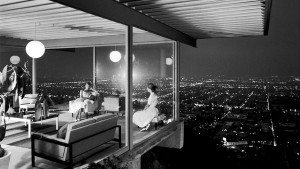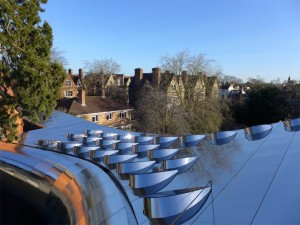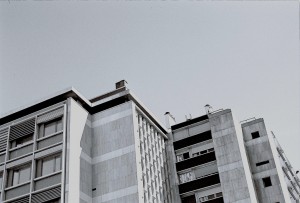
Glassy-Eyed: A polemic against glass buildings
by George Grylls | March 7, 2015
The vogue for christening new additions to the London skyline with cheerful nicknames began with the “Gherkin” in 1999. Ever since, architectural practices seem to have taken these nicknames as an affirmation of their work, or rather a tool to secure affirmation. A panoply of skyscrapers with equally friendly names have sprouted in the wake of Foster’s corporate helter skelter: the Shard, the Cheesegrater, the Walkie-Talkie. Yet what these nicknames hide, or perhaps satirically highlight, is a pernicious epidemic in architecture.
It is not the height of these buildings which is grotesque, rather their uniform adherence to one unpleasant material: glass. The Gherkin, the Shard, the Cheesegrater and the Walkie-Talkie are merely the most conspicuous examples of a wider trend for unadulterated floor-to-ceiling glass. Some of those who once embraced this style now abhor it. Ken Shuttleworth, one of the architects of the Gherkin, recently described his Frankenstein thus:
“The Gherkin is a fantastic building. But we can’t have that anymore. We can’t have those all-glass buildings. We need to be much more responsible.”
In London the Gherkin was the catalyst for ‘glass architecture’, but the Shard was its apogee. It is the physical, figurative and titular hero of glass architecture, its name a piercing reminder of its material. Around it, glass has encroached on the urban landscape like a virulent anaesthetic, not only in London, but across the world.
Glass architecture is an evolution of the International Style, whose name is indicative of its worldwide success. Its forerunners were the Bauhaus architects of Weimar Germany. Having emigrated to the more opulent USA, their commissions drastically increased in size. Terrifyingly beautiful towers of functionalism such as the Seagram Building prompted a global glut of ersatz recreations. Gleaming prisms now bespeckle many of the world’s super-cities. Those countries with relatively newfound wealth, particularly in the Middle and Far East, have become the greatest endowed.
Marrying the ethos of the Bauhaus and the rigours of Le Corbusier, the International Style is a term loosely applied to these Modernist buildings of the 20th century, which embody simplicity, elegance and functionality. Draw a skyscraper in Pictionary and it will be of the International Style. Its success was perhaps its own perversion; imitated so widely it became dull and occasionally horrifying. Architecture has since suffered an anxiety of influence, both in the thrall of the International Style and trying desperately to diverge from it. Note how the silhouettes of the four London skyscrapers listed at the start manipulate themselves into a ‘quirky’ shape in order to compensate for their derivative glassy façades. Perhaps the Gherkin’s pixelated triangles of blue and green lend it originality, but the Walkie-Talkie’s bloated sides smack of desperation.
The International Style’s most prolific architect was Ludwig Mies van der Rohe, the final director of the Bauhaus. His most influential building was ironically never built – a radically pure glass masterpiece that predates the International Style’s later boom. His entry to the 1921 Berlin Friedrichstrasse Skyscraper Competition was so simple it only needs three adjectives to describe it: glass, steel and sharp. The Shard is its elongated refinement, 92 years in the offing. But the corporate use of the Shard is simultaneously the pollution of a crystalline ideal. As a member of the radically socialist Novembergruppe, Mies van der Rohe had been dedicated to the utopian marriage of Art and the people. Glass was an appropriate material to encourage openness and cooperation. William J.R. Curtis, in his seminal Modern Architecture since 1900, rails against the appropriation of Mies van der Rohe’s Friedrichstrasse design:
“It is a sad irony of ensuing history that the pure glass prism should have started off as the symbol of a new faith and ended up as the banal formula for the housing of big business and bureaucracy.”
Glass’ growing presence in architecture is also due to advances in glass manufacturing. It was not until the 1950s that the Pilkington Process allowed continuous streams of glass to be produced cheaply. Yet only 60 years after glass became available for widespread use as a primary building material, we have learnt that it is unsuitable for this task due to its poor insulating qualities. Of course those grand corporations, which can afford to hire a ‘starchitect’ to build their crystal tower, can equally afford to pump sterile air around their offices to combat the effects of radiation.
Such wasteful expenditure of energy is increasingly subject to restrictions. In the UK all new private sector buildings from 2019 must be ‘zero carbon’. Amazingly, so fervent is the desire to build in glass that the current fashionable solution is to design angular glass buildings with wonky protrusions rather than embrace a mixed-material approach. The theory is that by imbuing your building with growths it shades itself, preventing radiation (e.g. the proposed Zig-Zag building, complete with twee nickname). The results are more often akin to acute elephantiasis.
The Viet Café knows all too well about glass’s unpredictability. The next-door-neighbours of the Walkie-Talkie were able to fry eggs in the 70°C ‘death-ray’ that the building’s concave glass created in the summer of 2013. Somewhat unbelievably the ‘Walkie-scorchie’s’ architect Rafal Viñoly’s previous Vdara building in Las Vegas had similarly taken inspiration from Die Another Day, reflecting and concentrating a sunbeam that was able to melt lounge-chairs.
Yet my gripe against glass is much more aesthetic than technical. There is no textural quality to glass; it is not exciting to look at. The emphasis is not on viewing the glass building, but the view from out of the glass building. However, when glass is adjacent to glass, surrounded by glass, the original purpose is distorted and the emphasis is shifted to looking in. Maybe the glass on a building is no different to the glass of a phone screen – a tool with which to inspect other people’s digital and physical lives. Indeed, glass is increasingly being used in residential buildings. We are edging ever closer to the totalitarian, nightmarish city-state in Evgeniy Zamyatin’s dystopic novel We, constructed entirely of glass.
Overusing glass is obviously counterintuitive. In an urban context, one glass building impinges on the views from another. Glass is thus most effective away from the city. Mies van der Rohe’s most enduring and universally worshipped legacy to glass is the Farnsworth House of 1951, a privately commissioned country retreat in rural Illinois. The sheer glass walls are intended to create harmony with its carefully chosen setting in the shade of a large Black Maple (now sadly deceased) with sweeping views down to the Fox River. Mies van der Rohe said of his project: “If you view nature through the glass walls of the Farnsworth House, it gains a more profound significance than if viewed from the outside. That way more is said about nature – it becomes part of a larger whole.”
Glass cities cannot hope to achieve this, so urban reconstruction must become reacquainted with traditional materials – brick, wood, stone, concrete – as well as embracing possible materials of the future such as plastics and cardboard. Architecturally successful cities are not dominated by the hegemony of one material but rather the cocktail of many. Glass currently predominates because it pays to have a view – the Walkie-Talkie bulges at the top to maximise floor space on the ‘more desirable’ and hence more expensive higher levels. Such architectural pandering to corporate clients is lazy and impinges on the public’s aesthetic experience of the city.
Instead, an architectural concept commonly associated with the exteriors of buildings should be applied more often internally. ‘Denial and reward’ allows the viewer to catch glimpses of a building on approach to it, whilst withholding the full panorama until the most opportune moment, as if creating a cliff-hanger for the rewarding finale. The individual eventually tires of looking out on totally uninterrupted vistas yet developers still stick religiously to the mantra of glass and views, glass and views. When everything is available, nothing becomes precious.
Glass is dangerous. It is subtle enough for us to become immune to its increasing ubiquity, yet total exposure is irrevocably damaging. Mies van der Rohe’s most famous aphorism is, “less is more.” So it is with glass architecture.




